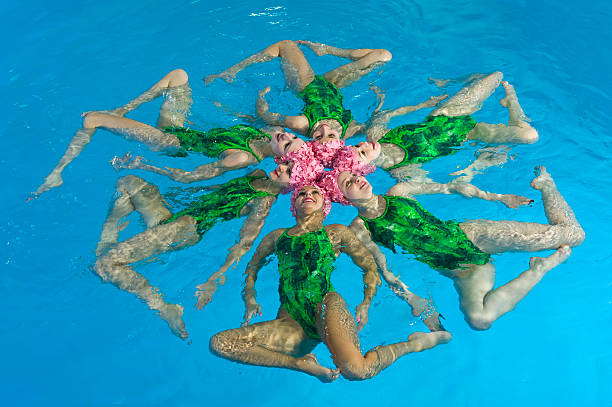Synchronized Swimming: The Aquatic Ballet Revolution
Synchronized swimming, a captivating blend of artistry and athleticism, has transformed from a niche spectacle into a globally recognized competitive sport. This aquatic discipline demands exceptional strength, flexibility, and grace, pushing the boundaries of human performance in water. As we dive into the world of synchronized swimming, we'll explore its rich history, technical intricacies, and the physical prowess required to excel in this mesmerizing sport.

The Birth of Aquatic Artistry
Synchronized swimming’s roots can be traced back to the early 20th century, when water ballets and ornamental swimming gained popularity in Europe and North America. These aquatic performances, often featuring elaborate costumes and music, laid the foundation for what would eventually become synchronized swimming. The sport’s modern form began to take shape in the 1930s, thanks to pioneering figures like Katherine Curtis, who organized the first synchronized swimming competition in Chicago in 1939.
As the sport gained traction, it quickly evolved from a purely aesthetic display to a competitive discipline. The first official synchronized swimming competition was held in 1940, and by the 1950s, it had become a recognized sport in many countries. The International Swimming Federation (FINA) officially recognized synchronized swimming in 1952, paving the way for its inclusion in major international competitions.
Throughout the 1960s and 1970s, synchronized swimming continued to grow in popularity and complexity. The sport’s technical elements became more standardized, and scoring systems were refined to better evaluate both artistic impression and technical merit. This period also saw the emergence of iconic figures like Esther Williams, whose aquatic performances in Hollywood films helped bring synchronized swimming to a broader audience and inspire a new generation of athletes.
Technical Mastery and Physical Demands
Synchronized swimming is far more than just graceful movements in water. It requires an exceptional level of physical fitness, technical skill, and mental fortitude. Athletes must possess a unique combination of strength, flexibility, endurance, and lung capacity to perform the intricate routines that define the sport.
One of the most challenging aspects of synchronized swimming is the ability to perform complex movements while maintaining precise body control underwater. Athletes must execute intricate leg movements, known as eggbeater kicks, to keep their upper bodies stable above the water’s surface. This technique requires tremendous leg strength and stamina, as swimmers often maintain this position for extended periods during their routines.
Flexibility is another crucial component of synchronized swimming. Athletes must be able to contort their bodies into various positions, both above and below the water, often while inverted or spinning. This requires extensive training in gymnastics and dance, as well as specialized stretching routines to improve overall flexibility and range of motion.
Perhaps one of the most impressive aspects of synchronized swimming is the athletes’ ability to hold their breath for extended periods. During underwater segments of their routines, swimmers must perform complex movements while holding their breath for up to a minute or more. This requires not only exceptional lung capacity but also mental discipline and the ability to remain calm under pressure.
Choreography and Artistic Expression
While the physical demands of synchronized swimming are undeniable, the sport’s artistic elements are equally important. Choreography plays a crucial role in creating routines that are both technically impressive and visually captivating. Synchronized swimming routines are carefully crafted to tell a story or convey a theme, with movements synchronized to music and often incorporating elements of various dance styles.
Choreographers work closely with athletes to develop routines that showcase their strengths while pushing the boundaries of what’s possible in the water. This process involves countless hours of brainstorming, experimentation, and refinement to create a cohesive and impactful performance. The choice of music is also critical, as it sets the tone for the routine and helps guide the swimmers’ movements and emotions.
In recent years, synchronized swimming choreography has become increasingly innovative, incorporating elements from other disciplines such as contemporary dance, acrobatics, and even martial arts. This evolution has led to more dynamic and visually stunning routines, further elevating the sport’s appeal to audiences and judges alike.
The Olympic Journey and Global Recognition
Synchronized swimming’s journey to Olympic recognition was a long and arduous one. The sport made its Olympic debut as a demonstration event at the 1984 Los Angeles Games, featuring solo and duet competitions. It wasn’t until the 1988 Seoul Olympics that synchronized swimming was officially included as a medal sport, with duet and team events.
Since its inclusion in the Olympic program, synchronized swimming has continued to evolve and gain global recognition. The sport has seen a significant increase in participation from countries around the world, with traditional powerhouses like Russia, China, and Japan being joined by emerging nations in the competitive arena.
The Olympic competition format has also undergone changes over the years. In 1996, the solo event was replaced by a team event, emphasizing the importance of group synchronization and cooperation. More recently, the introduction of mixed-gender events has further diversified the sport and opened up new possibilities for artistic expression and technical innovation.
Training Regimens and Sports Science
The pursuit of excellence in synchronized swimming requires a comprehensive and rigorous training regimen. Athletes typically spend several hours a day in the pool, perfecting their techniques and rehearsing routines. However, their training extends far beyond the water, incorporating a wide range of dry-land exercises and cross-training activities.
Strength training is a crucial component of a synchronized swimmer’s preparation. Athletes focus on building core strength, leg power, and upper body endurance through a combination of weightlifting, plyometrics, and bodyweight exercises. Flexibility training is equally important, with many swimmers incorporating yoga, Pilates, and specialized stretching routines into their daily regimens.
In recent years, sports science has played an increasingly important role in synchronized swimming training and performance optimization. Biomechanical analysis is used to refine technique and improve efficiency in the water, while physiological testing helps athletes and coaches tailor training programs to individual needs. Nutritional strategies are carefully developed to support the demanding physical requirements of the sport while maintaining the lean physiques necessary for optimal performance.
Mental preparation is another critical aspect of synchronized swimming training. Athletes must develop strong concentration skills, spatial awareness, and the ability to perform under pressure. Many teams incorporate visualization techniques, mindfulness practices, and sports psychology sessions into their training programs to enhance mental resilience and performance consistency.
Judging Criteria and Scoring Systems
The evaluation of synchronized swimming performances is a complex process that considers both technical merit and artistic impression. Judges must assess a wide range of factors, including synchronization, difficulty of movements, execution, choreography, and overall impression.
The technical elements of a routine are evaluated based on their difficulty, precision, and execution. Judges look for clean lines, proper body positioning, and seamless transitions between movements. Synchronization is a key component of the technical score, with judges assessing how well the swimmers move in unison with each other and the music.
Artistic impression is equally important in the overall evaluation. Judges consider factors such as choreography, use of space, creativity, and interpretation of the music. The ability to convey emotion and tell a story through movement is highly valued, as is the overall impact and entertainment value of the performance.
In recent years, the scoring system for synchronized swimming has undergone several revisions to improve transparency and reduce subjectivity. The current system uses a combination of technical and artistic scores, with specific criteria for each element of the routine. This approach aims to provide a more accurate and fair assessment of performances while still allowing for artistic interpretation and innovation.
Technological Advancements and Innovation
As with many sports, technology has played an increasingly important role in the evolution of synchronized swimming. Advances in swimwear design have led to the development of specialized suits that enhance performance and visual appeal. These suits are engineered to provide optimal buoyancy and reduce drag, allowing swimmers to move more efficiently through the water.
Underwater speakers and lighting systems have revolutionized the way synchronized swimming routines are performed and experienced. These technologies allow for more immersive and dynamic performances, with music and lighting effects enhancing the visual impact of the routines.
Video analysis software has become an invaluable tool for coaches and athletes, allowing for detailed review and refinement of techniques and choreography. Underwater cameras provide unique perspectives that help swimmers and coaches identify areas for improvement that may not be visible from above the surface.
Virtual reality and augmented reality technologies are also beginning to find applications in synchronized swimming training. These tools can provide swimmers with immersive practice environments and help them visualize complex routines before entering the water.
Cultural Impact and Media Representation
Synchronized swimming has had a significant cultural impact, both as a competitive sport and as a form of artistic expression. The sport’s unique blend of athleticism and aesthetics has inspired numerous artistic works, including films, photography exhibitions, and contemporary dance performances.
In popular culture, synchronized swimming has often been portrayed with a mix of fascination and humor. While some representations have perpetuated stereotypes or misconceptions about the sport, others have helped to showcase its complexity and demands. As the sport continues to evolve and gain recognition, more accurate and nuanced portrayals are emerging in media and popular culture.
The sport has also played a role in challenging gender norms in athletics. While traditionally dominated by female athletes, synchronized swimming has seen increasing participation from male swimmers in recent years. The introduction of mixed-gender events at major competitions has further contributed to breaking down gender barriers in the sport.
Global Participation and Cultural Exchange
Synchronized swimming has become a truly global sport, with participation from countries across six continents. This international growth has led to a rich exchange of ideas, techniques, and cultural influences within the sport. Different nations bring their unique artistic traditions and athletic approaches to synchronized swimming, resulting in a diverse and ever-evolving competitive landscape.
International competitions serve as platforms for cultural exchange, allowing athletes and coaches from different backgrounds to learn from one another and push the boundaries of the sport. This cross-pollination of ideas has contributed to the rapid evolution of synchronized swimming techniques and choreography, making the sport more dynamic and exciting for participants and spectators alike.
The global nature of synchronized swimming has also helped to promote understanding and cooperation between nations. Through shared passion for the sport, athletes and coaches from diverse backgrounds come together, fostering international friendships and collaborations that extend beyond the pool.
Future Directions and Challenges
As synchronized swimming continues to evolve, it faces both exciting opportunities and significant challenges. One of the primary goals for the sport’s governing bodies is to increase global participation and visibility. Efforts are being made to promote synchronized swimming in developing nations and to attract more male athletes to the sport.
Another area of focus is the continued refinement of judging criteria and scoring systems. As routines become increasingly complex and innovative, there is an ongoing need to ensure that evaluation methods keep pace with the sport’s evolution. This includes developing more objective measures for assessing artistic elements while still allowing for creativity and individual expression.
The integration of new technologies presents both opportunities and challenges for synchronized swimming. While advancements in training tools and performance analysis can enhance athlete development, there is a need to balance technological innovation with the sport’s traditional elements and values.
Environmental concerns, particularly related to water quality and conservation, are also becoming increasingly important in the world of synchronized swimming. As awareness of these issues grows, the sport may need to adapt its practices and venues to ensure sustainability and environmental responsibility.
Conclusion: The Enduring Appeal of Aquatic Artistry
Synchronized swimming stands as a testament to the incredible potential of human performance in the aquatic environment. Its unique blend of athletic prowess, artistic expression, and technical precision continues to captivate audiences and inspire athletes around the world. As the sport evolves, it pushes the boundaries of what is possible in water, challenging our perceptions of physical limits and artistic potential.
From its humble beginnings as a form of aquatic entertainment to its current status as a highly competitive Olympic discipline, synchronized swimming has undergone a remarkable transformation. The dedication, skill, and creativity of athletes and coaches have elevated the sport to new heights, creating performances that seamlessly blend strength, grace, and artistry.
As we look to the future, synchronized swimming is poised to continue its growth and evolution. With ongoing innovations in training methods, technology, and artistic expression, the sport will undoubtedly produce even more breathtaking displays of aquatic mastery. Whether as a competitive pursuit or a form of artistic expression, synchronized swimming remains a powerful reminder of the beauty and potential of human movement in harmony with water.





